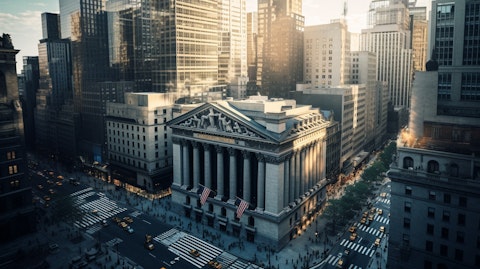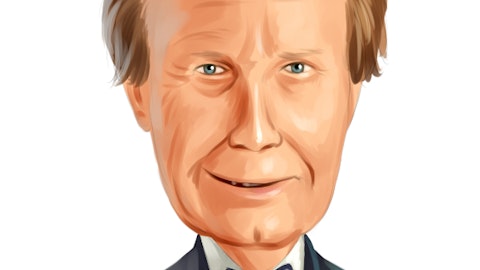Grosvenor Capital Management, L.P. (NASDAQ:GCMG) Q4 2023 Earnings Call Transcript February 13, 2024
Grosvenor Capital Management, L.P. misses on earnings expectations. Reported EPS is $0.17 EPS, expectations were $0.18. Grosvenor Capital Management, L.P. isn’t one of the 30 most popular stocks among hedge funds at the end of the third quarter (see the details here).
Operator: Good day, and welcome to the GCM Grosvenor 2023 Fourth Quarter and Full Year Results Call. Later, we will conduct a question-and-answer session. [Operator Instructions] As a reminder, this call will be recorded. I would now like to hand the call over to Stacie Selinger, Head of Investor Relations. You may begin.
Stacie Selinger: Thank you. Good morning and welcome to GCM Grosvenor’s fourth quarter and full year 2023 earnings call. Today I am joined by GCM Grosvenor’s Chairman and Chief Executive Officer, Michael Sacks; President, Jon Levin; and Chief Financial Officer, Pam Bentley. Before we discuss this quarter’s results, a reminder that all statements made on this call that do not relate matters of historical fact should be considered forward-looking statements. This includes statements regarding our current expectations for the business, our financial performance and projections. These statements are neither promises nor guarantees. They involve known and unknown risks, uncertainties, and other important factors that may cause our actual results to differ materially from those indicated by the forward-looking statements on this call.
Please refer to the factors in the risk factors section of our 10-K, our other filings with the Securities and Exchange Commissions and our earnings release, all of which are available on the public shareholder section of our website. We’ll also refer to non-GAAP measures that we view as important in assessing the performance of our business. A reconciliation of non-GAAP metrics to the nearest GAAP metric can be found in our earnings presentation and earning supplement, both of which are available on our website. Our goal is to continually improve how we communicate with and engage with our shareholders and in that spirit, we look forward to your feedback. Thank you again for joining us and with that, I’ll turn the call over to Michael.
Michael Sacks: Thank you, Stacie, and thank you all for joining us. We are pleased to report solid results for the fourth quarter and full year 2023, despite the challenging environment for our industry. Importantly, 2023 was another year in which we delivered value to client portfolios, strengthened and expanded our platform, and grew our earnings power and our intrinsic value for shareholders. Our Board increased our stock buyback authorization by $25 million, which we intend to use throughout the year, and maintained our dividend rate at $0.11 per share per quarter which represents a dividend yield of 5% as of Friday’s close. Our dividend payments are comfortably serviced by our trailing fee-related earnings. From a financial standpoint, 2023 was a solid year and we finished the year strong.
Fee-related earnings grew 23% over Q4 ’22 and 9% year-over-year. Since 2020, we’ve grown fee-related earnings at a 14% compound annual growth rate. Our fee-related earnings margin grew to 38% for the year compared to 36% in 2022. The high FRE margin in Q4 was the result of tightly managed headcount and final compensation decisions that were reflective of the environment. Our FRE margin has grown by 700 basis points over the last three years as our business has continued to enjoy considerable operating leverage and scalability. We continue to forecast margin expansion going forward. One of the key drivers of our business over the past three years has been the shift towards private market strategies, which as of year-end comprise 71% of our assets under management and 65% of our fee-paying AUM.
In 2023, private markets again experienced consistent growth with management fees, excluding catch-up fees, increasing by double digits year-over-year in each quarter. As we discussed, throughout the year, 2023 was a tough market environment for fundraising, which was primarily the result of low levels of transaction activity in private market strategies. As we expected, our fundraising momentum did pick up throughout the year, with more capital raised in the second half of 2023. The fundraising environment is continuing to loosen up, which bodes well for 2024. Real assets has continued to perform well. Infrastructure and real estate were the top two contributors to fundraising during 2023, with $3.6 billion raised in aggregate. Taken together, real assets AUM has more than doubled over the past three years to just over $20 billion, and these strategies now represent over 25% of our total AUM.
Capital raising from sources outside of the US was strong, comprising 51% of 2023 fundraising compared to 40% of our AUM. As you know, we’ve invested in business development in geographies outside of the US over the last few years, opening offices in Germany, Canada and Australia. While expanding in new channels takes time, it’s nice to see some early signs of our business development investments working. In 2024, we expect continued strong client re-ups and solid specialized funds fundraising inside of our traditional institutional channels. We are also focused on expanding our efforts in the individual investor channels generally. We see a strong pipeline everywhere and are particularly optimistic with regard to the infrastructure and credit verticals.
Jon will talk a bit more about credit in a moment. Mentioned investment performance earlier, and we were pleased with performance across our strategies this past year. In particular, we were pleased that our absolute return strategies investment performance exceeded our base case assumptions, beating benchmarks and peers. As a result, a significant portion of ARS portfolios are now in a position to earn full performance fees in 2024 delivering more revenue in 2024 than we received in 2023 for the same level of performance. While it’s too soon to predict a material shift in ARS flows, we’re seeing increased demand from current and prospective clients, with fewer currently scheduled future redemptions than we have seen at this time in recent years.
Our private market strategy’s performance was also constructive, and our significant dry powder, which exceeds $9 billion at year-end, continues to put us in a good position to deploy capital into an increasingly attractive environment. Importantly, we enter 2024 with strong private markets incentive fee earnings power, which is positioned to deliver significant revenue growth over the coming years as transaction activity returns. This is clearly presented on Slide 12. As you can see, in both 2020 and 2021, we realized revenue from carry of more than 15% of our beginning year unrealized carried interest balance with $59 million and $122 million of gross carry revenue, respectively. Since then, while realizations and therefore gross carry revenue have been muted, our carried earnings power has grown substantially.
You’ll see our unrealized carried interest has approximately doubled during the last three years. In addition, we’ve raised $11.6 billion of capital for direct-oriented private market strategies over the last three years. Nearly all of that capital is either recently deployed or dry powder yet to be deployed, meaning, it is not yet in our unrealized carry balance. We believe the inflection of this revenue line is a when, not an if, and we look forward to that revenue line returning to more normal levels in the future. With the capital markets and M&A environment slowly improving, sponsors seem to be committed to driving to a higher degree of realizations this year. This should lead to more carry revenue and to positive developments with regard to fundraising.
Current and prospective client activity has already picked up and based on our current pipeline, we expect 2024 fundraising to exceed 2023. We continue to believe that we are well set up for continued growth into the future. With regard to management fees and fee-related earnings, our platform breadth provides us with a lot of ways to win. It’s as strong as it’s ever been, and it’s getting stronger. We have continued operating leverage and a solid compound growth rate in our FRE over the next several years, and based on our trajectory, we’re confident in our ability to double our fee-related earnings over the next five years. When combined with the built-in growth in our incentive fee line that I discussed, we feel good about our adjusted EBITDA and adjusted net income growth as well.

And with that, I’ll turn the call over to Jon.
Jonathan Levin: Thank you, Michael. As Michael noted, our confidence in our long-term trajectory is rooted in the strength of our platform, the significant opportunity from new but adjacent initiatives, and embedded operating leverage in the business. The programmatic nature of our private markets client relationships, which experience re-ups every three years to four years at approximately 90% re-up rates, often at larger sizes than predecessor programs, sets a foundation for growth and stability in the business. Beyond re-ups, we have a proven track record of expanding our client relationships into new areas. As of year-end, 50% of our top 50 clients work with us in multiple verticals, and 60% of our top clients work with us in both separate account and specialized fund form.
We believe key macro trends and our associated positioning will drive business growth over the next three years to five years. Those trends include the high demand for infrastructure, the persistent proliferation of sustainable and impact investing, the continued growth of the alternative credit category, and the democratization of alternatives through the emergence of the individual investor. We have addressed infrastructure and impact investing on recent earnings calls and believe both of these areas have potential to grow substantially in size and revenue over the coming years. Today, I will dive a bit deeper into the private credit category. Private credit has already grown tremendously as an asset class, more than doubling in the past five years, from approximately $720 billion to an estimated $1.6 trillion at the end of 2023.
Non-bank lenders now account for three-quarters of the market, and there have been over 500 funds dedicated to private credit that have raised capital in the past two years. Disruptions in the banking sector, last year, some of which continue today, create an even more urgent need for more sources of capital, further accelerating the sector’s momentum. Against this backdrop, limited partners are rapidly evolving their approach to investing in private credit. While historically LPs have invested in private credit as part of a fixed income or a private equity or a broader private markets allocation, increasingly, investors of all sizes are creating a discrete private credit allocation. Accordingly, we believe the future of credit will be similar to how we’ve seen the evolution in private equity and more recently in infrastructure.
As investors grow and evolve their allocation to the asset class, solutions providers like GCM Grosvenor are well-suited partners. We are able to build a single point of access that is diversified across implementation type funds, co-investments, secondaries and direct investments as well as across areas of focus, type of credit market, cap size, sector and region. Even for investors that started their allocation by investing directly in some of the large well-known funds, solutions providers serve as a diversifier through our broader network of primary funds and execution of co-investments and secondary investments. Our open architecture sourcing engine is a key differentiator when it comes to private credit, and we see more than 500 credit investment opportunities annually.
Our presence in liquid and illiquid alternatives offer a massive funnel for the origination of credit investment opportunities, and we benefit from being able to offer these capabilities through both custom accounts as well as commingled funds. Our opportunistic credit fund, SCF II, had its first closing during the fourth quarter. As of year-end, we have $13 billion of credit assets under management, and we look forward to providing you with further updates on our success in this area as we move forward. And with that, I’ll turn the call over to Pam.
Pamela Bentley: Thanks, Jon. Our results for the quarter and year were consistent with our expectations and once again demonstrated our earnings quality and scalability of the platform. Assets under management were $77 billion as of year-end, a 4% increase from a year ago, and fee-paying AUM increased 5% year-over-year. Private markets continues to be a key growth driver with private markets AUM and fee-paying AUM growing by 7% and 9% year-over-year, respectively. As of year-end, our private markets business represents 71% of total AUM and 65% of our fee-paying AUM. Private markets management fees, excluding catch-up fees in the quarter grew by 11% year-over-year, achieving a double-digit growth rate once again in line with our expectations.
We have enjoyed a 13% compound annual growth rate in private markets management fees since 2020. Turning to ’24, in the first quarter, we anticipate private markets management fees, excluding catch-up fees, will grow in the mid-to-high single digits over the prior year. For the full year ’24, we once again expect double-digit private markets management fee growth, excluding catch-up fees. Absolute return strategies management fees were relatively stable in Q4 as compared to last quarter, and we expect first-quarter ARS management fees to again be stable on a sequential basis. Most importantly, we are pleased with our ARS investment performance for the year, which is expected to have positive ramifications in ’24 and beyond. We realized $20 million of incentive fees in the quarter and $65 million in the year.
Michael spoke earlier about our significant earnings potential from carried interest. While it’s difficult to predict timing of carry realizations, the high diversification of our carry makes it especially valuable given its limited single-asset exposure. As of year-end, we have $776 million in gross unrealized carried interest across 137 programs, the firm’s share of which is $373 million. Our share of carry has nearly tripled in the last three years. Our annual performance fees are tied to ARS investment returns and typically crystallize in the fourth quarter each year. Entering ’24, our run rate annual performance fees are $28 million, assuming normalized returns of 8% for multi-strategy and 10% for opportunistic investments. Turning to our expenses.
Our compensation strategy is rooted in fostering alignment between our employees, clients, and shareholders. FRE compensation was $33 million in the quarter and $149 million in the year. Importantly, we look at FRE compensation on a full-year basis, and consequently, the amount of compensation on a quarter-to-quarter basis can fluctuate. As a result, it is most appropriate to look at the ’23 average quarterly FRE compensation as a baseline for the first quarter of ’24. Non-GAAP general and administrative and other expenses were $19.5 million in the quarter. We continue to be disciplined around expenses and expect this figure to remain stable in the first quarter. Pulling together these factors on a year-over-year basis, fee-related earnings grew a healthy 23% in the quarter and 9% for the year.
Adjusted net income grew 48% and 9% in the quarter and year, respectively. Our FRE margin grew from 36% in 2022 to 38% in ’23, and we expect further FRE margin expansion in ’24 as we continue to harness the scalability of our business. We are maintaining a healthy quarterly dividend of $0.11 per share or a yield of 5% as of last Friday, and there is room for future dividend growth. In the case of share buybacks, we repurchased nearly 4 million shares in ’23, and we ended the year with 187 million shares outstanding. We continue to believe that our current stock price is at an attractive level relative to market value, and our Board has recently authorized an additional $25 million per share buybacks, leaving us with $65 million remaining in our share buyback authorization as of today.
Reiterating our view on ’24, we feel confident in our plans to achieve continued double-digit growth in private market [Technical Difficulty] management fees, stabilization of ARS management fees, expanded FRE margin, and significant growth potential in our incentive fee revenues. Looking further into the future, we are focused on doubling our fee-related earnings in the next five years with continued fee-related earnings margin expansion. We look forward to the opportunities ahead to deliver value to our clients and shareholders. Thank you again for joining us, and we’re now happy to take your questions.
See also 20 Most Meat Eating States Per Capita and Top 20 Chocolate Companies in the World by Revenue.
Q&A Session
Follow Gcm Grosvenor Inc.
Follow Gcm Grosvenor Inc.
Operator: Thank you. [Operator Instructions] Our first question is coming from Crispin Love with Piper Sandler.
Crispin Love: Thanks. Good morning everyone. Appreciate taking my questions. Just first on fundraising, you saw a stronger second half of the year than the first, as you expected. But can you just drill a little bit deeper into your expectations for ’24? Do you expect the momentum from the fourth quarter to continue, and what are the areas that you’re most excited about for fundraising? And is there anything to call out as it relates to cadence for the year based on what you know today?
Michael Sacks: Sure. Yeah. Thanks for the question. Crispin, it’s Michael. So we are — we’re actually feeling good about fundraising. Our pipeline is very full. It’s full on re-up, it’s full on separate account, it is full on specialized fund, actually stronger than it’s been in a while on ARS. And — so we are encouraged that some of the progress that we saw throughout the year, last year, from the first quarter of ’23 through the end of the year, will continue. As I mentioned in my remarks, we think infrastructure and credit will see healthy fund flows during the year and we’re enthusiastic about that. We’re focused on doing a bit more in the individual investor space this year, which we’re encouraged by, and that’s frankly a longer-term opportunity for us.
And just generally, I think the environment has improved on flows, pipeline has built and is larger and we hope to see that momentum continue. And I think we said in the comments, we think fundraising in ’24 will exceed ’23 levels for the full year. Like always, we’ll build a little bit as we go through the year and we’ll expect the back half to have, in a constructive environment, more fundraising in the front end (ph).
Crispin Love: Thank you, Michael. Appreciate the color there. And then just on FRE margins, you had a really nice acceleration in the quarter. I think it was a record level for you. But just looking at 2024 FRE margins and if there was anything one time in the fourth quarter that drove the cash-based employee comp cost to be lower than your initial guide for the quarter. Just curious what changed between your last call and kind of through the quarter. You did mention the tightening headcount, but just curious what that means for 2024 as you move through the year for FRE margins.
Michael Sacks: Yeah. We mentioned tightly managed headcount and also just final comp decisions reflective of the environment. And I think Pam mentioned in her comments that looking at kind of the average FRE, quarterly FRE, for ’23 is sort of the right way to think about FRE comp expense — the average FRE comp expense for ’23 is the right way to think about the FRE comp expense for the first quarter of ’24. I think the important point on our FRE comp and our FRE, in general, is that we believe, and we’ve been consistent in mentioning this for a while, that we continue to have operating leverage in our FRE line with growth and that we can continue to drive our FRE margins up with growth, putting aside doing anything like we’ve seen some of the peers do with their carry.
And so we think we’ve got operating leverage still remaining in our FRE line. We believe we’re going to be able to drive FRE margins in ’24. And I think we gave pretty good picture of how you should be thinking about first-quarter FRE comp for your models.
Crispin Love: Thanks, Michael. That’s it for me. I appreciate you taking my questions.
Michael Sacks: Thank you.
Operator: [Operator Instructions] Our next question is coming from Bill Katz with TD Cowen.
Bill Katz: Okay. Thank you very much for the commentary and the guidance. Maybe a couple of big picture questions for today. Jon, thank you so much for the update on the credit platform. What product specifically do you see the opportunity setting into 2024? And then maybe even a bigger-picture discussion. You mentioned that sort of the emergence of the allocation. Where is that coming from? Does it come from private equity and real estate? Does it come from sort of public market, equity, fixed income, just sort of sense? What are your clients telling you in terms of where they’re reallocating from?
Jonathan Levin: Sure, Bill, happy to take that. Yeah, I would probably start — I’ll start with the second part of the question first. I think it totally depends on the client. I think for a lot of folks, the kind of origin of the private credit allocation comes out of the fixed income bucket. For a lot of them, it might come out of a more liquid alternatives bucket. For some of them, it might come out of kind of a private equity bucket, or in some cases, all the above. And I think just generally speaking, the idea that private credit is a distinct allocation and therefore needs to kind of be a program that is built for persistence and for continuity over time is kind of the real theme. I think for us, I would probably focus less, Bill, on a specific product.
I think that the way I would think about it is similar to how we’ve built the other alternative verticals at the firm, is that it’s a kind of holistic solution that can be offered either through commingled fund form or through separate account form. And inside that holistic solution is the ability to help clients access certain funds as a primary fund investor that they might not otherwise be doing on their own. A lot of folks have built reasonably developed kind of sponsor-back direct lending businesses in the middle market and the large end of the market. But there may be other types of credit on the smaller end, or other types of credit like asset-backed credit or securitized credit, or different types of things that they might need help with in terms of finding funds.
But I think one of the most exciting opportunities, though, is as the market in credit develops and evolves, similar to what you’ve seen in private equity and infrastructure and other asset classes, the ability to also help build out co-investment programs, secondary allocations, and so really thinking of it as kind of that same open architecture approach with flexible implementation, flexible delivery models for the clients that you’ll see evolve in private credit, similar to what you’ve seen in some of the other asset classes.
Bill Katz: All right. Thank you for that. And just as a follow-up, I’m going to cheat and ask a two-part unrelated question, so I apologize in advance, but when you mentioned that you think you can have better asset gathering in ’24 versus ’23, I was just sort of wondering, looking at Page 9 of your slide deck, does the year look like 2022? Do you get back to something that’s a little more elevated like 2021? And then unrelated, but just in terms of capital allocation, you mentioned that you got the Board authorization, which I think is about 4% of your market cap now, a new number. How do you think about that pacing of buyback and sort of trying to balance the — what you see as the value of the stock versus the liquidity dynamic? Thank you.
Michael Sacks: It’s Michael. On the first question, I think we’re — our internal bottoms-up build, working with our BD team and looking at our pipeline, it has a year for us that’s frankly significantly better than ’23 on fundraising, not ’21. It’s maybe in line with the other chart — bar charts you cite on Page 9. But important is the composition of fundraising inside those lines and what it is that you’re raising funds for, what those fee levels are, and when those fees turn on, and we do think with reasonable amounts of fundraising, certainly consistent with our budget with pipeline for a couple of the funds where the fees turn on right away and we have some catch-up fees, we have a lot of leverage, if you will, in a — frankly, a similar level or a fundraising to that which we’ve seen in the past.
So that all — we’ve got a long way to go, but that momentum that we saw in the back half and in the fourth quarter, we think that will continue. And we’re pretty enthusiastic with regard to that. In terms of capital allocation, we are aware that our limited float is not one of our great assets and so we are conscious of that. At the same time, we like the value of our stock. And so the approach that we’ve taken is to just try to minimize the impact of dilution from stock-based compensation and kind of have that as a goal. And the pacing of that is driven as much by sort of the vesting dates on stock-based compensation as anything else, obviously, opportunistically, when we see periods of time that we think represent particularly strong value, we in general, we [Technical Difficulty] that up.
But in general, we’re — we do not want to shrink the float too much. We think that’s part of what holds us back. And so we’ve sort of settled on this idea of we’re going to manage such that we’re not diluting ourselves too much and we’re putting that money to work in buying back shares.
Bill Katz: Thanks so much.
Operator: Our next question is coming from Chris Kotowski with Oppenheimer & Company.
Chris Kotowski: Yeah. Good morning. Thank you. You’ve touched on this already and I heard Pam’s guidance about looking at the free comp and the carry comp or incentive comp is — on a full-year basis. But just want to make sure I understand, just because it does come on the heels of announcements by Carlyle and KKR, that they are changing their compensation model to be — to throw more of the comp burden against carry and incentive rather than base management fees. And did I hear you to say that that’s not what’s going on, this is just the normal, or should we kind of expect to move…
Michael Sacks: Correct.
Chris Kotowski: In that direction?
Michael Sacks: Correct. No, you heard that correctly, and we were careful to try to say that we think we have expanding FRE margin from growth without doing that. And then we are cognizant of the opportunity associated with that. But what we’ve talked about does not rely on us seizing that opportunity at all. And at this time, we are not — we have no plan to do that. We think we can drive our FRE margins without that. In think — if I can shamelessly flatter you, I think the way you wrote that up was similar to the way that we sort of view it, which is not entirely clear how it pencils out on a trade, but when you factor in the sort of multiple differential between the two different revenue lines, it works out well for the shareholders.
And I think we sort of view it the same way and we probably own a larger percentage of the company than most. So we’re going to obviously look at all of those alternatives and options over time, but our views on FRE margin and the guidance PAM gave on FRE comp expense does not assume that we do something major like that.
Chris Kotowski: Okay. Great. Just wanted to clarify that. That’s it for me. Thank you.
Operator: Our next question is coming from Ken Worthington with J.P. Morgan.
Ken Worthington: Hi. Good morning. Thanks for taking the question. So I may be crazy here. I hate to do this on a public call, but I thought the guidance was for private market fundraising to be greater in the second half than the first, and that 3Q was sort of lighter and we were expecting sort of a bigger pop in 4Q. It looks to me, and maybe my numbers are wrong, but that to get there, you needed about $1.2 billion of additional fundraising than you got in 4Q kind of hit that guidance. Am I completely off base here, or did fundraising get pushed from 4Q to 1Q?



